cruise control MITSUBISHI ECLIPSE 1990 User Guide
[x] Cancel search | Manufacturer: MITSUBISHI, Model Year: 1990, Model line: ECLIPSE, Model: MITSUBISHI ECLIPSE 1990Pages: 391, PDF Size: 15.27 MB
Page 177 of 391
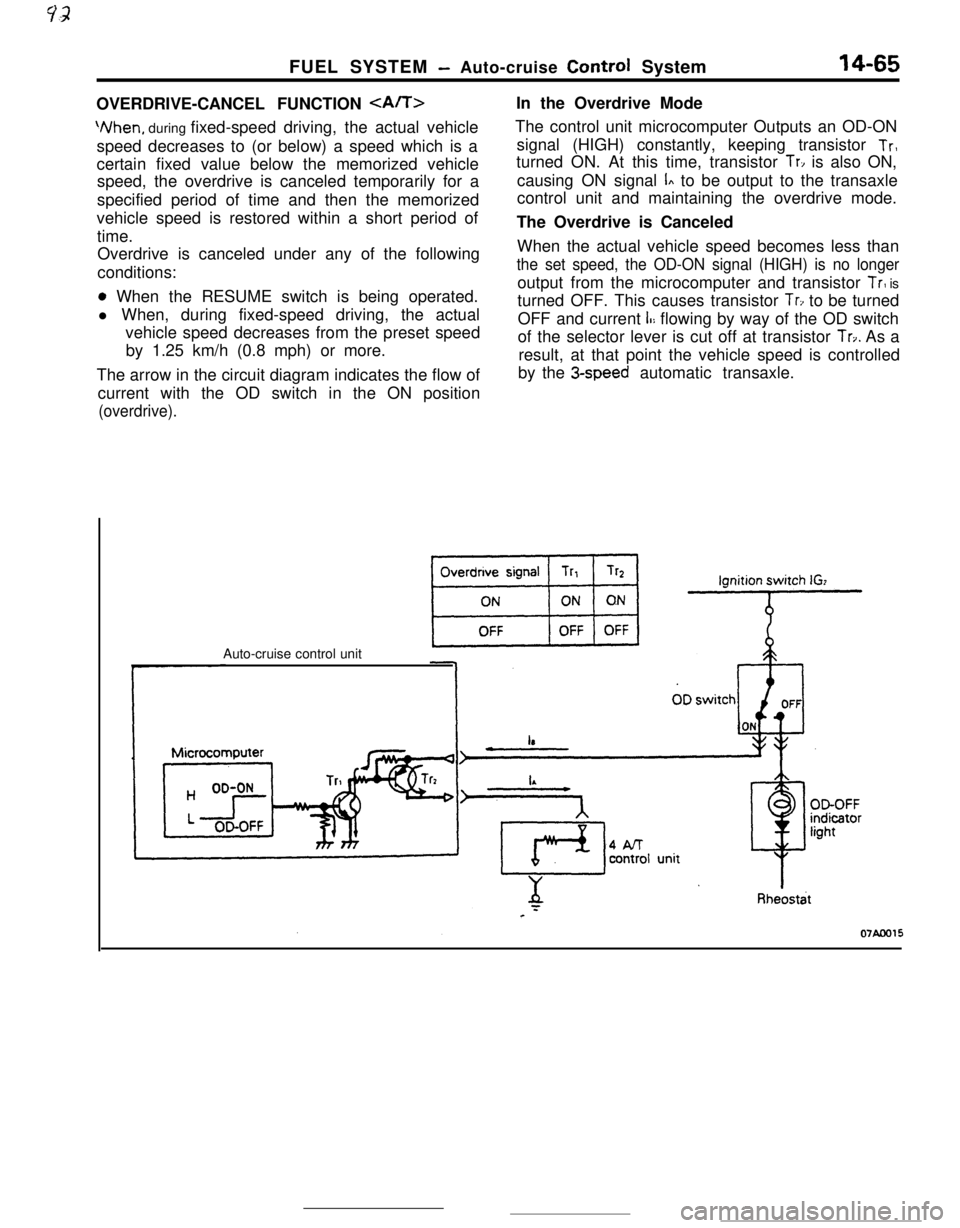
Page 178 of 391
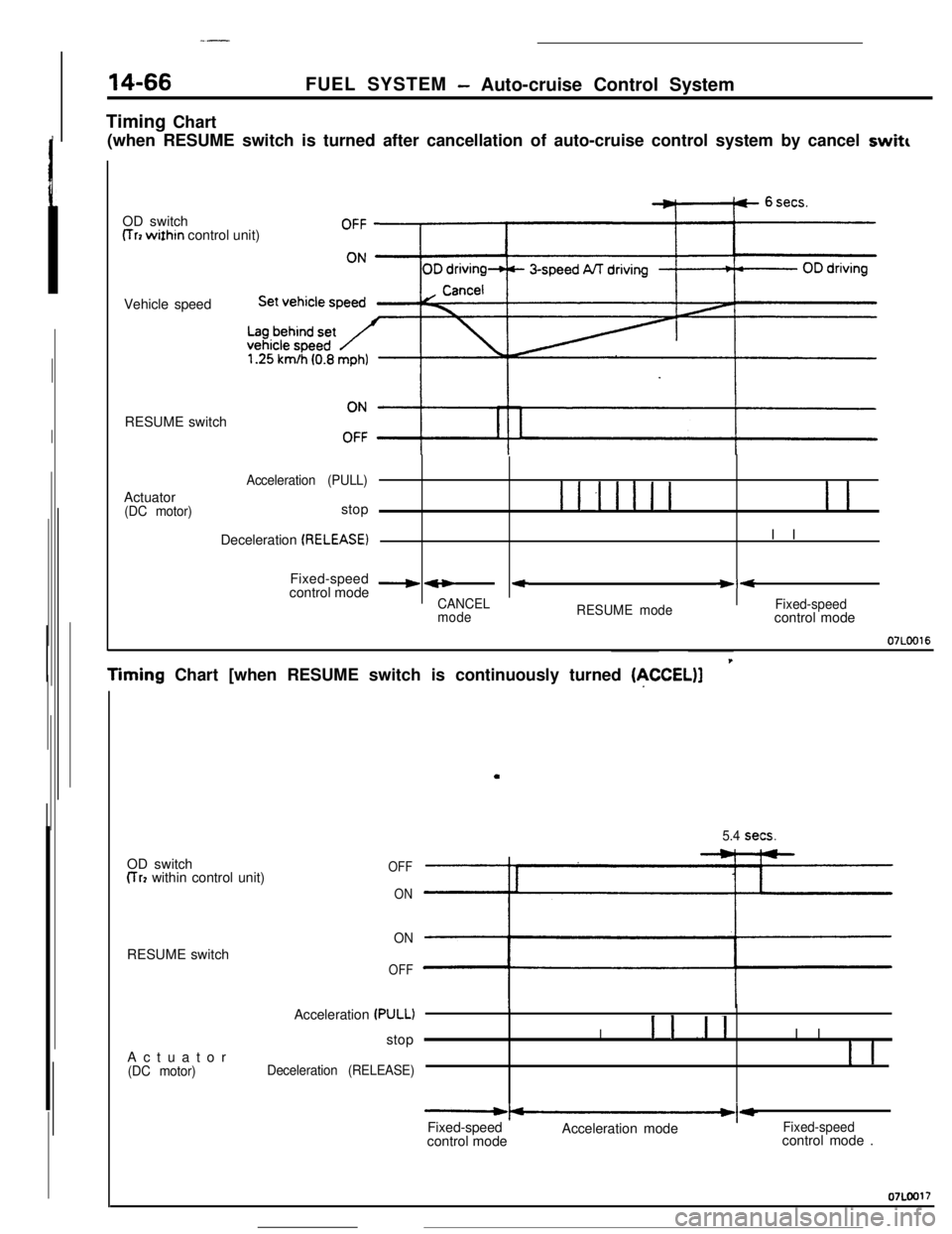
--
14-66FUEL SYSTEM- Auto-cruise Control System
Timing Chart
(when RESUME switch is turned after cancellation of auto-cruise control system by cancel
switcOD switch
CTrz wi!hin control unit)
Vehicle speed
RESUME switch
Acceleration (PULL)Actuator
(DC motor)stopI I -I I I I II IDeceleration
(RELEASE)I I
Fixed-speed
- *control mode+ +
CANCEL
modeRESUME mode
-4
Fixed-speedcontrol mode
07LOO16
iming Chart [when RESUME switch is continuously turned (ACCEL)]
.OD switch
(Tr, within control unit)OFF
ON
5.4 sets.RESUME switch
ON
OFFAcceleration
(PULL)stop
II 1. .I I
Actuator
(DC motor)Deceleration (RELEASE)I IFixed-speed
’control modeAcceleration modeIFixed-speedcontrol mode .
07LOO17
Page 179 of 391
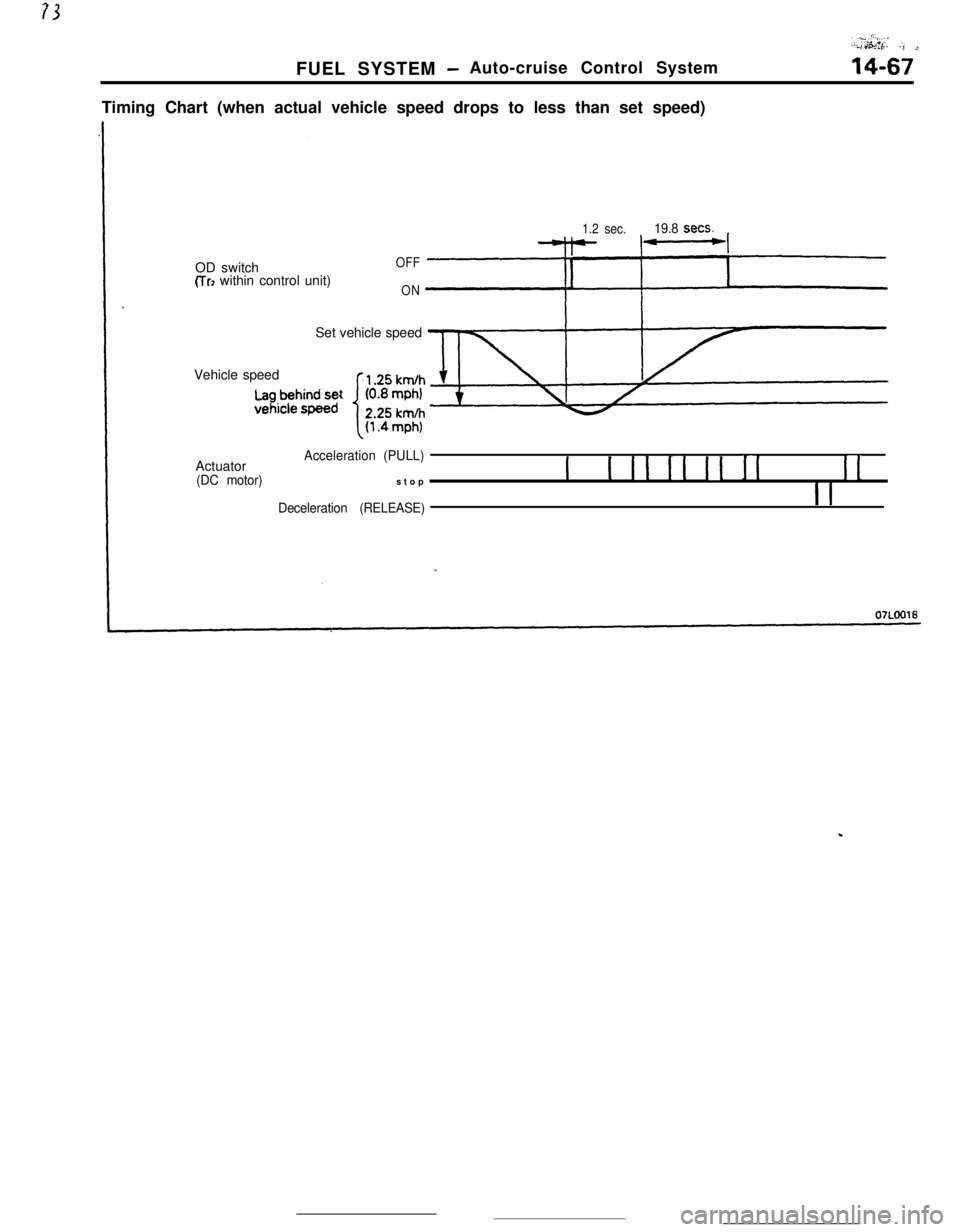
.&$&: -‘$ ~FUEL SYSTEM
-Auto-cruise Control System14-67Timing Chart (when actual vehicle speed drops to less than set speed)
OD switch
(Trl within control unit)
OFF
ON1.2 sec.
19.8 sets.Set vehicle speed
Vehicle speed
Actuator
Acceleration (PULL)
(DC motor)stop
II II II II IIII
Deceleration (RELEASE)I I
.
Page 180 of 391
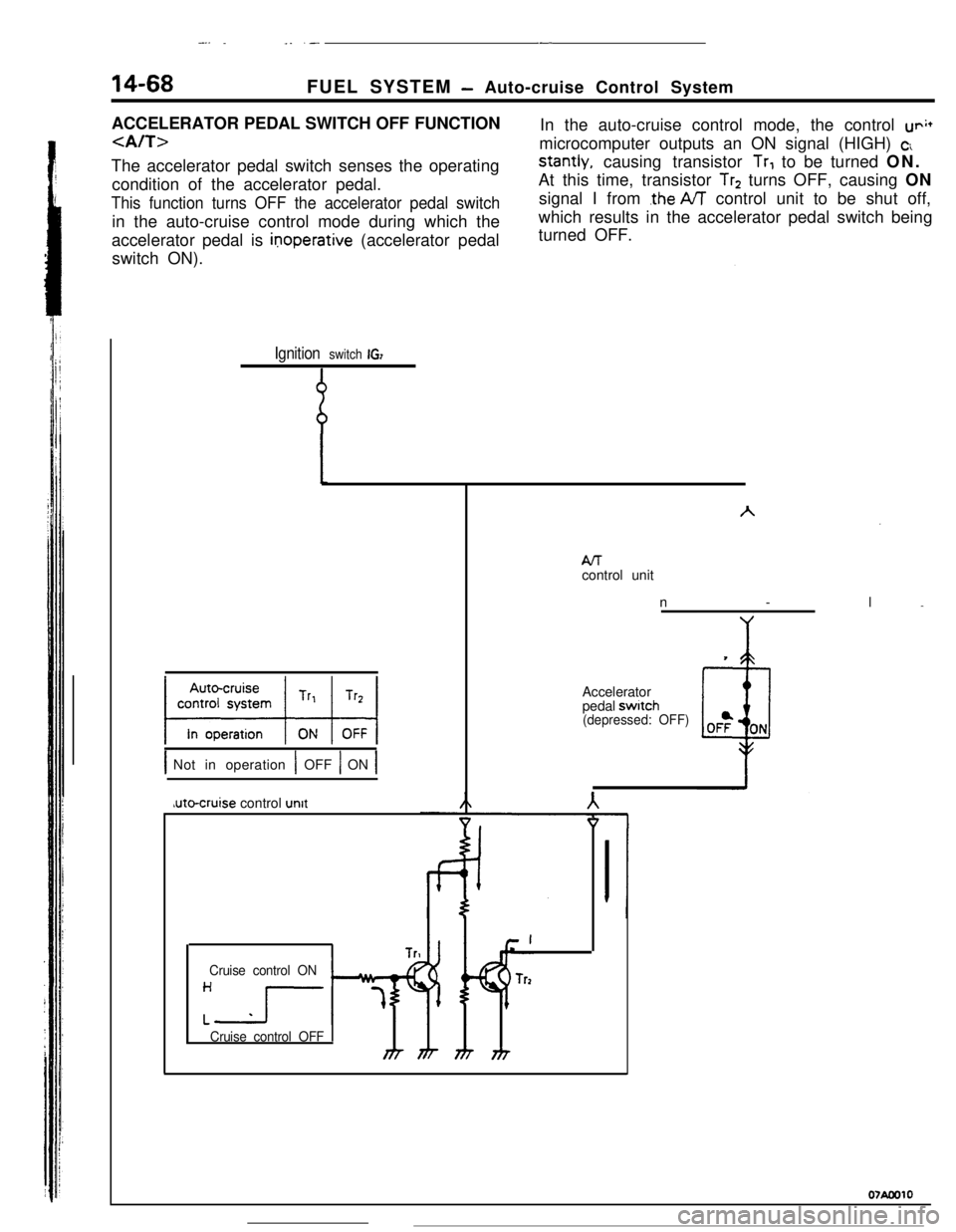
-.. ._. .-.._ _
14-68FUEL SYSTEM - Auto-cruise Control System
ACCELERATOR PEDAL SWITCH OFF FUNCTION
The accelerator pedal switch senses the operating
condition of the accelerator pedal.
This function turns OFF the accelerator pedal switchin the auto-cruise control mode during which the
accelerator pedal is
inoperative (accelerator pedal
switch ON).In the auto-cruise control mode, the control
UP;+microcomputer outputs an ON signal (HIGH)
c,stantly, causing transistor
Tr, to be turned ON.
At this time, transistor
Tr2 turns OFF, causing ON
signal I from
.the A/r control unit to be shut off,
which results in the accelerator pedal switch being
turned OFF.
Ignition switch IG7
Ancontrol unitn-l
‘.
INot in operation 1 OFF 1 ON 1Accelerator
pedal switch
(depressed: OFF)uto-cruise control
unit
V
Cruise control ON
Cruise control OFF
mm&m07AoQ10
Page 181 of 391
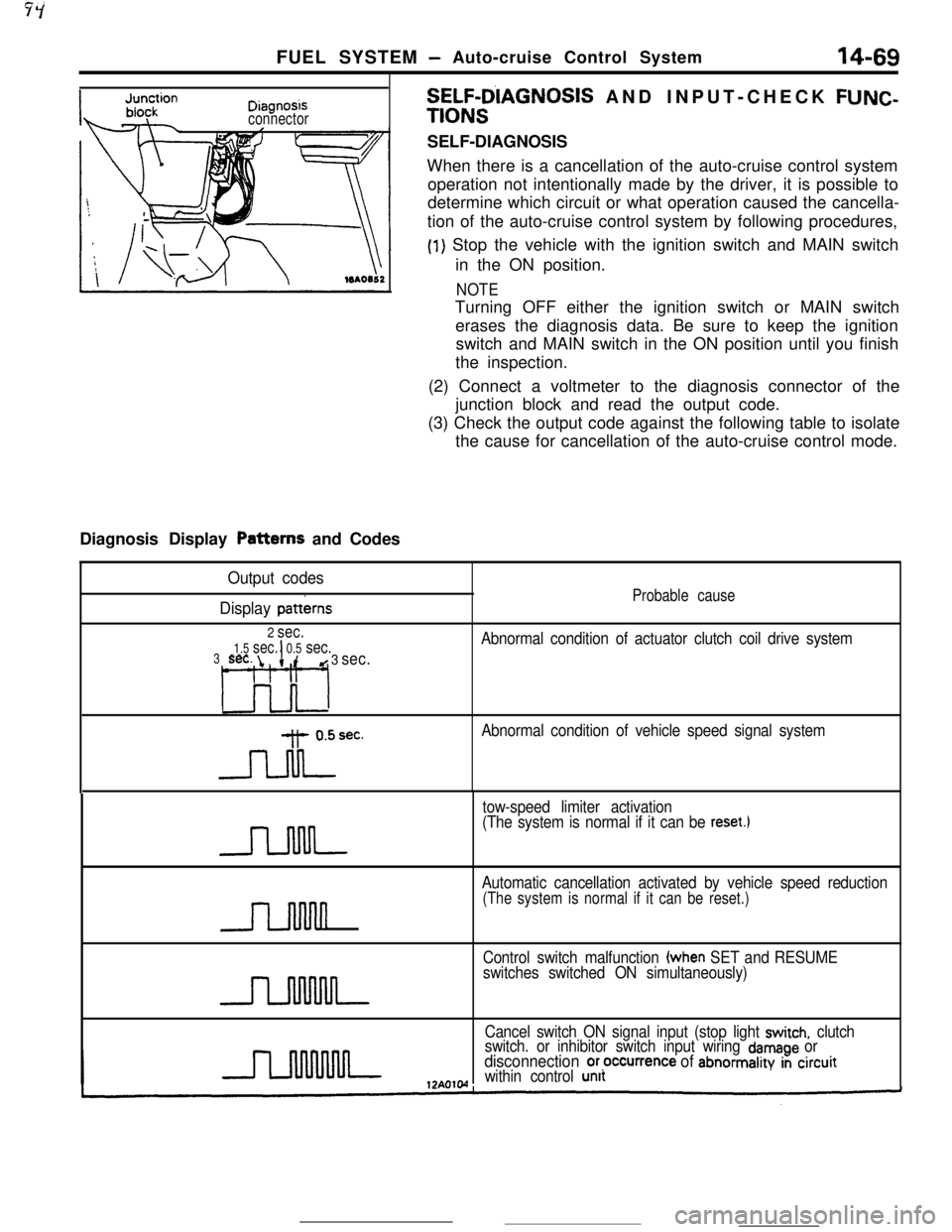
FUEL SYSTEM- Auto-cruise Control System14-69
ni2nnncisv,“y’I”“.-
connectorDiagnosis Display Patterns and Codes
SELF-D’IAGNOSIS AND INPUT-CHECK FUNC-
TIONSSELF-DIAGNOSIS
When there is a cancellation of the auto-cruise control system
operation not intentionally made by the driver, it is possible to
determine which circuit or what operation caused the cancella-
tion of the auto-cruise control system by following procedures,
(1) Stop the vehicle with the ignition switch and MAIN switch
in the ON position.
NOTETurning OFF either the ignition switch or MAIN switch
erases the diagnosis data. Be sure to keep the ignition
switch and MAIN switch in the ON position until you finish
the inspection.
(2) Connect a voltmeter to the diagnosis connector of the
junction block and read the output code.
(3) Check the output code against the following table to isolate
the cause for cancellation of the auto-cruise control mode.
Output codes
Display
patterns
2 sec.
1.5 sec.I0.5 sec.3sec. id 3 sec.
L3o-l
-Jdrec.
Probable cause
Abnormal condition of actuator clutch coil drive system
Abnormal condition of vehicle speed signal system
tow-speed limiter activation
(The system is normal if it can be
reset.1
n
Automatic cancellation activated by vehicle speed reduction
(The system is normal if it can be reset.)
Control switch malfunction (when SET and RESUME
switches switched ON simultaneously)
Cancel switch ON signal input (stop light
switch, clutch
switch. or inhibitor switch input wiring damage ordisconnection or,occurrence of abnormality in circuitwithin control unit
Page 182 of 391
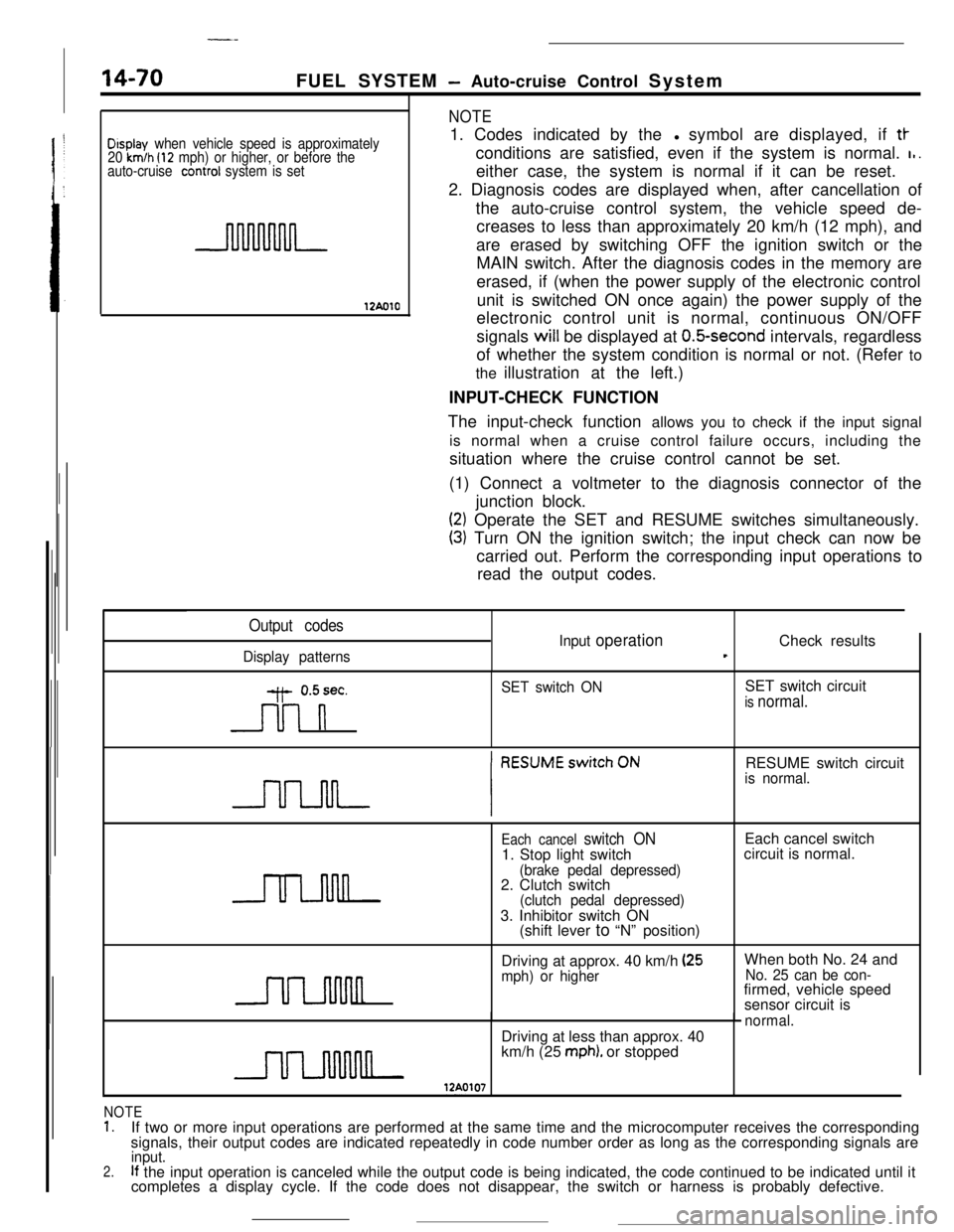
14-70
-_FUEL SYSTEM
- Auto-cruise Control System
Display when vehicle speed is approximately
20 km/h (12 mph) or higher, or before the
auto-cruise conrrol system is set
12AolO
NOTE1. Codes indicated by thel symbol are displayed, if
tt-conditions are satisfied, even if the system is normal.
I,.either case, the system is normal if it can be reset.
2. Diagnosis codes are displayed when, after cancellation of
the auto-cruise control system, the vehicle speed de-
creases to less than approximately 20 km/h (12 mph), and
are erased by switching OFF the ignition switch or the
MAIN switch. After the diagnosis codes in the memory are
erased, if (when the power supply of the electronic control
unit is switched ON once again) the power supply of the
electronic control unit is normal, continuous ON/OFF
signals will be displayed at
O.&second intervals, regardless
of whether the system condition is normal or not. (Refer to
the illustration at the left.)
INPUT-CHECK FUNCTION
The input-check function allows you to check if the input signal
is normal when a cruise control failure occurs, including the
situation where the cruise control cannot be set.
(1) Connect a voltmeter to the diagnosis connector of the
junction block.
(2) Operate the SET and RESUME switches simultaneously.
(3) Turn ON the ignition switch; the input check can now be
carried out. Perform the corresponding input operations to
read the output codes.
Output codes
Display patternsInput
operationCheck resultst
y- 0.5sec.
n
SET switch ONSET switch circuitis normal.RESUME switch circuit
is normal.
Each cancel switch ON1. Stop light switch
(brake pedal depressed)2. Clutch switch
(clutch pedal depressed)3. Inhibitor switch ON
(shift lever to “N” position)Each cancel switch
circuit is normal.
Driving at approx. 40 km/h
(25mph) or higherWhen both No. 24 andNo. 25 can be con-firmed, vehicle speed
sensor circuit is
normal.Driving at less than approx. 40
km/h (25
mph). or stopped
NOTE1.If two or more input operations are performed at the same time and the microcomputer receives the corresponding
signals, their output codes are indicated repeatedly in code number order as long as the corresponding signals are
2.input.If the input operation is canceled while the output code is being indicated, the code continued to be indicated until it
completes a display cycle. If the code does not disappear, the switch or harness is probably defective.
Page 183 of 391
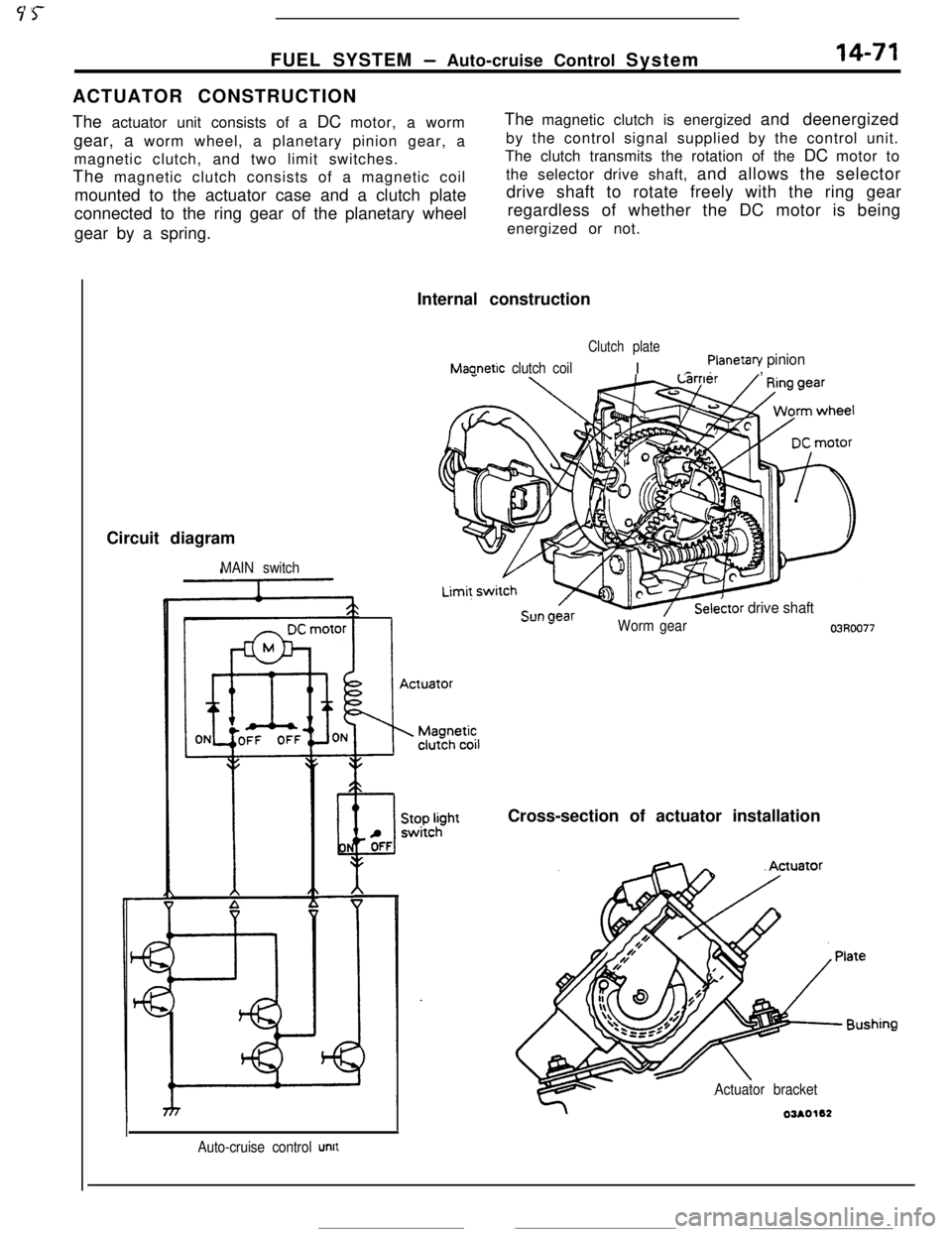
Y 5-FUEL SYSTEM
- Auto-cruise Control System14-71ACTUATOR CONSTRUCTION
The actuator unit consists of a DC motor, a worm
gear, a worm wheel, a planetary pinion gear, a
magnetic clutch, and two limit switches.
The magnetic clutch consists of a magnetic coil
mounted to the actuator case and a clutch plate
connected to the ring gear of the planetary wheel
gear by a spring.The magnetic clutch is energized and deenergized
by the control signal supplied by the control unit.
The clutch transmits the rotation of the DC motor to
the selector drive shaft, and allows the selector
drive shaft to rotate freely with the ring gear
regardless of whether the DC motor is being
energized or not.
Internal construction
Clutch plate
Maanetic clutch coilI ^. ,Planetan/ pinionCircuit diagram
MAIN switch
%tn m.=ir
Auto-cruise control unit
7S&&or drive shaft
Worm gear03R0077
Cross-section of actuator installation
Actuator bracket
Page 184 of 391
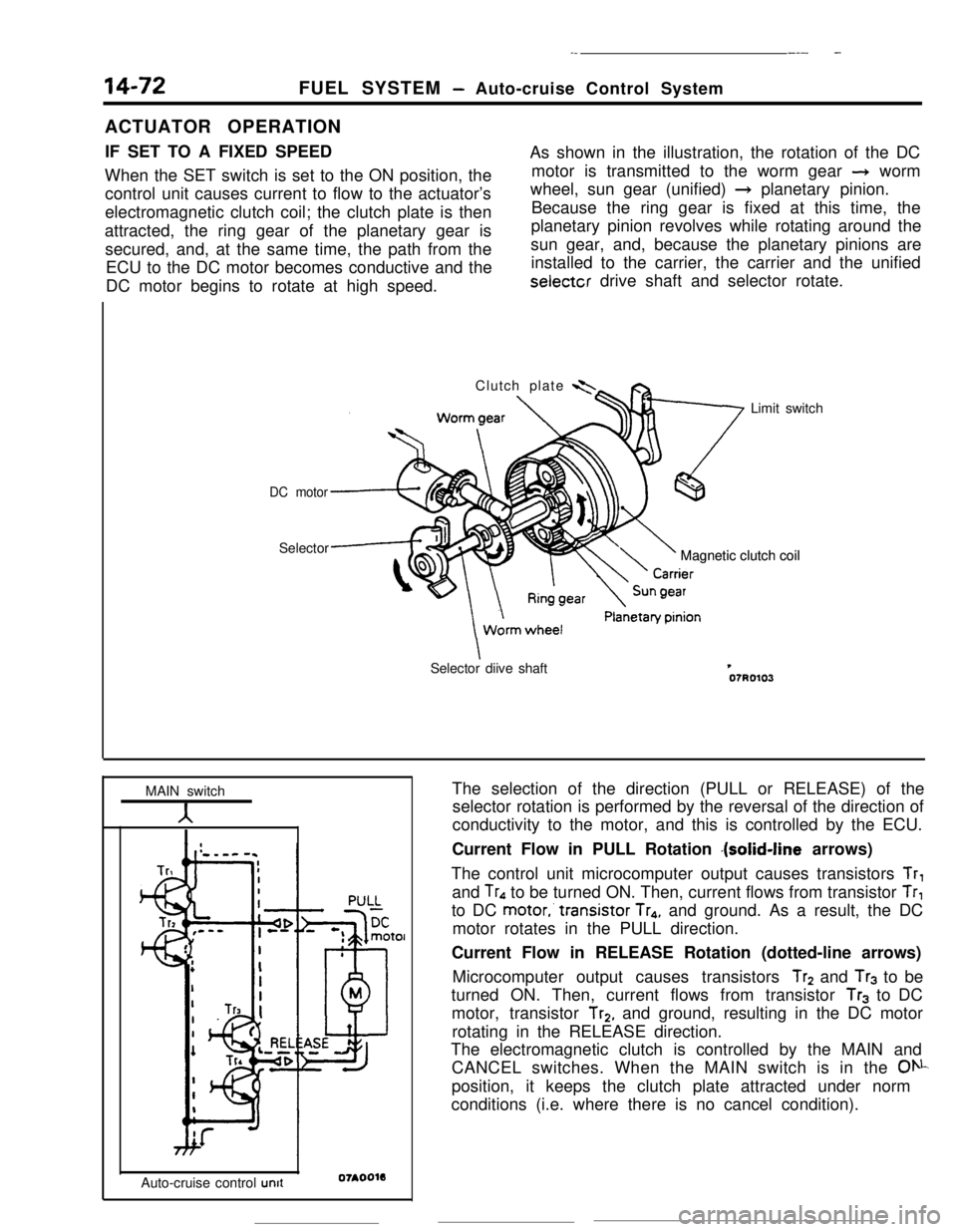
14-72
._FUEL SYSTEM
- Auto-cruise Control System
___ -ACTUATOR OPERATION
IF SET TO A FIXED SPEED
When the SET switch is set to the ON position, the
control unit causes current to flow to the actuator’s
electromagnetic clutch coil; the clutch plate is then
attracted, the ring gear of the planetary gear is
secured, and, at the same time, the path from the
ECU to the DC motor becomes conductive and the
DC motor begins to rotate at high speed.As shown in the illustration, the rotation of the DC
motor is transmitted to the worm gear
--, worm
wheel, sun gear (unified)
+ planetary pinion.
Because the ring gear is fixed at this time, the
planetary pinion revolves while rotating around the
sun gear, and, because the planetary pinions are
installed to the carrier, the carrier and the unifiedselectcr drive shaft and selector rotate.
Clutch plate
<
7 Limit switch
DC motorSelector
Magnetic clutch coil Magnetic clutch coil
Selector diive shaft
MAIN switchTrl
4sTn
aAuto-cruise control
unit07AOO11The selection of the direction (PULL or RELEASE) of the
selector rotation is performed by the reversal of the direction of
conductivity to the motor, and this is controlled by the ECU.
Current Flow in PULL Rotation
.(soiid-line arrows)
The control unit microcomputer output causes transistors
Tr,and Tr, to be turned ON. Then, current flows from transistor
Tr,to DC motor,‘transistor
Tr,, and ground. As a result, the DC
motor rotates in the PULL direction.
Current Flow in RELEASE Rotation (dotted-line arrows)
Microcomputer output causes transistors
Tr2 and Tr3 to be
turned ON. Then, current flows from transistor
Tr3 to DC
motor, transistor
Tr2, and ground, resulting in the DC motor
rotating in the RELEASE direction.
The electromagnetic clutch is controlled by the MAIN and
CANCEL switches. When the MAIN switch is in the
01\L.position, it keeps the clutch plate attracted under norm
conditions (i.e. where there is no cancel condition).
Page 185 of 391
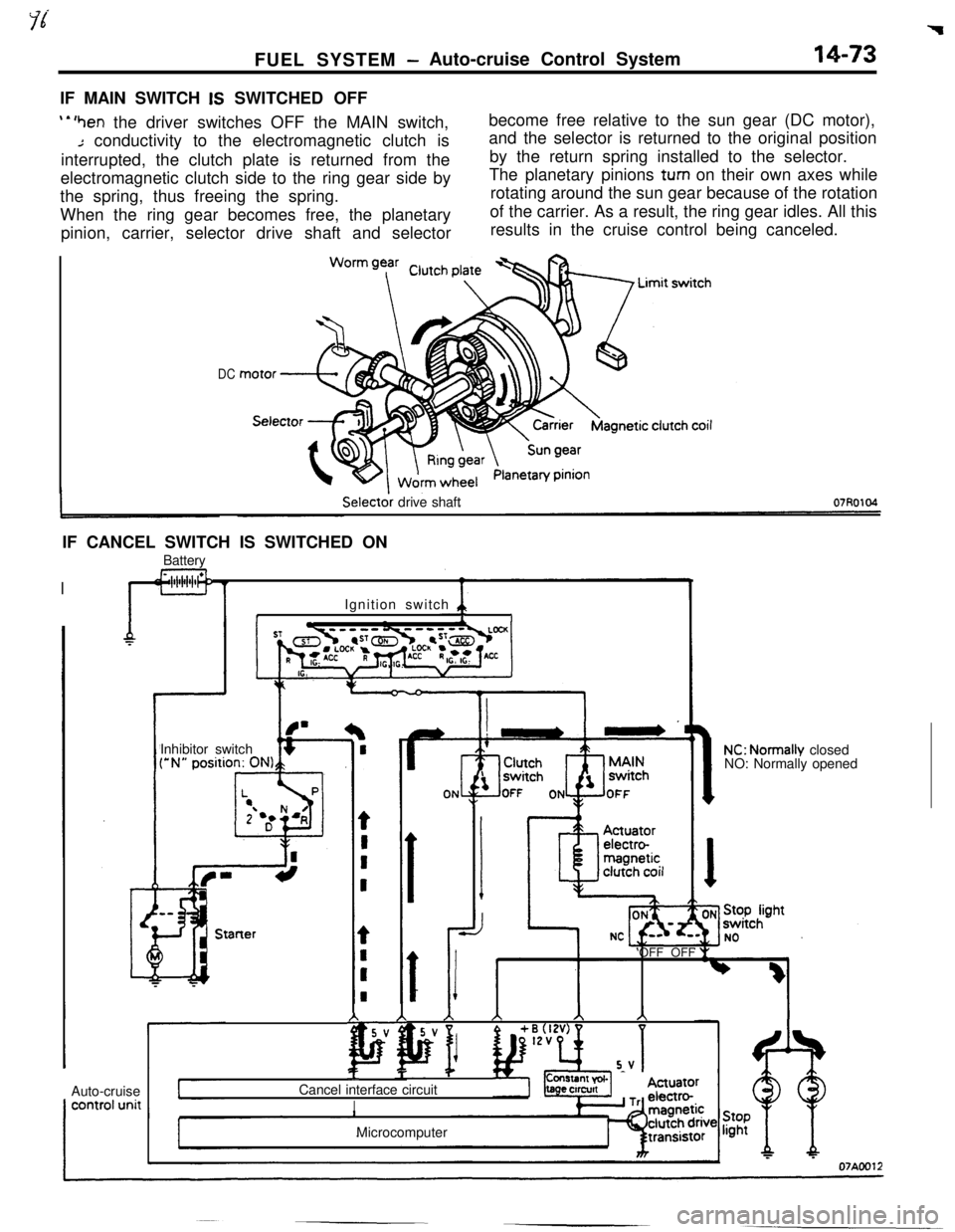
FUEL SYSTEM -Auto-cruise Control System14-73IF MAIN SWITCH
IS SWITCHED OFF
‘*‘hen the driver switches OFF the MAIN switch,
Jconductivity to the electromagnetic clutch is
interrupted, the clutch plate is returned from the
electromagnetic clutch side to the ring gear side by
the spring, thus freeing the spring.
When the ring gear becomes free, the planetary
pinion, carrier, selector drive shaft and selectorbecome free relative to the sun gear (DC motor),
and the selector is returned to the original position
by the return spring installed to the selector.
The planetary pinions
turn on their own axes while
rotating around the sun gear because of the rotation
of the carrier. As a result, the ring gear idles. All this
results in the cruise control being canceled.
DCSelector drive shaft
IF CANCEL SWITCH IS SWITCHED ON
IBattery
IIIIgnition switch 411IInhibitor switch
f’ J
r--
if-Starterz _Auto-cruise
f
AA)\AA
5V
pF p
+ i%zv)
5-VComl
Cancel interface circuit
bs- Tts ec
I
r-
[ON
NC: Normally closed
NO: Normally opened
‘OFF OFF
IMicrocomputer
Page 186 of 391
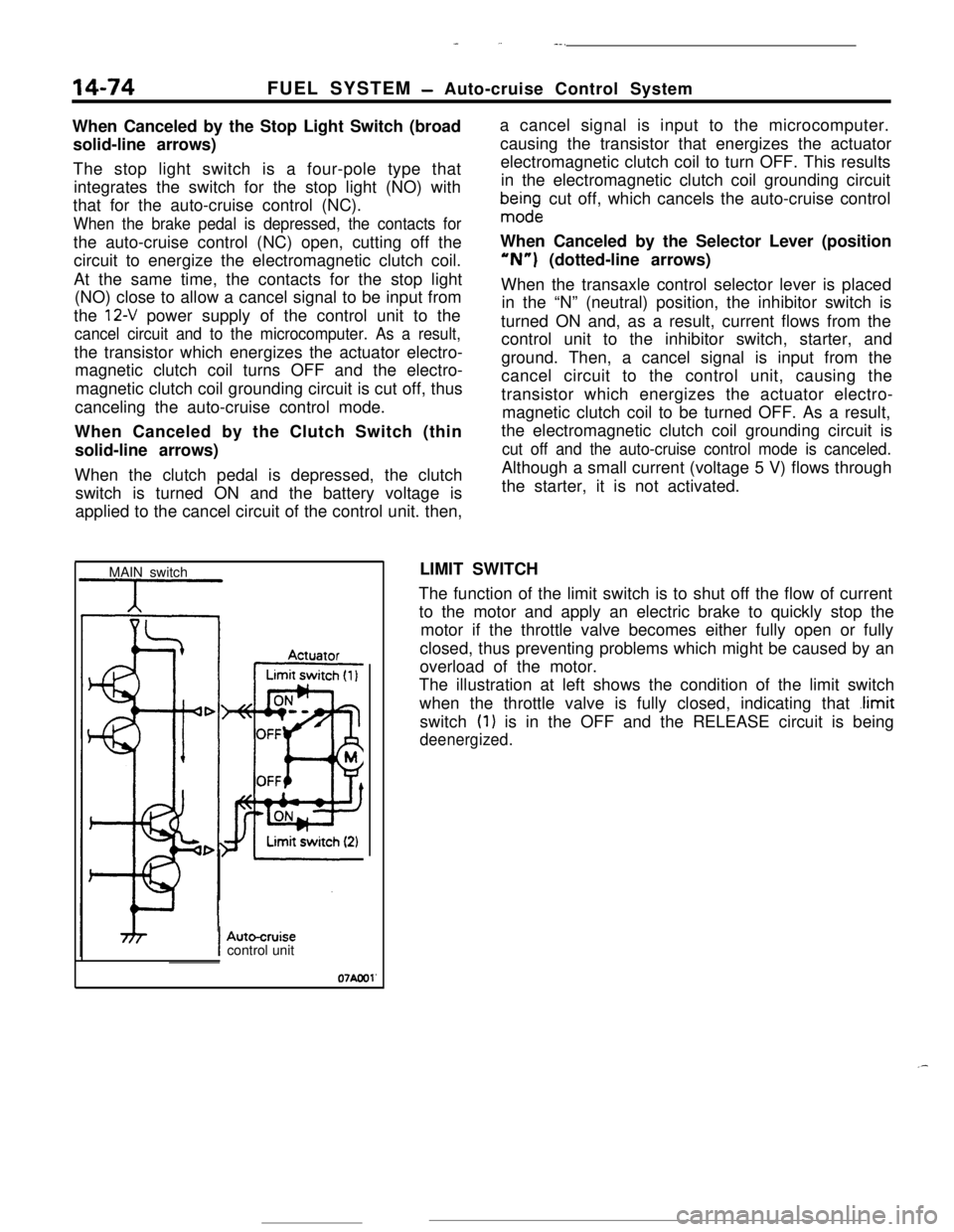
14-74
_ ,.-..FUEL SYSTEM
- Auto-cruise Control System
When Canceled by the Stop Light Switch (broad
solid-line arrows)
The stop light switch is a four-pole type that
integrates the switch for the stop light (NO) with
that for the auto-cruise control (NC).
When the brake pedal is depressed, the contacts forthe auto-cruise control (NC) open, cutting off the
circuit to energize the electromagnetic clutch coil.
At the same time, the contacts for the stop light
(NO) close to allow a cancel signal to be input from
the
12-V power supply of the control unit to the
cancel circuit and to the microcomputer. As a result,the transistor which energizes the actuator electro-
magnetic clutch coil turns OFF and the electro-
magnetic clutch coil grounding circuit is cut off, thus
canceling the auto-cruise control mode.
When Canceled by the Clutch Switch (thin
solid-line arrows)
When the clutch pedal is depressed, the clutch
switch is turned ON and the battery voltage is
applied to the cancel circuit of the control unit. then,a cancel signal is input to the microcomputer.
causing the transistor that energizes the actuator
electromagnetic clutch coil to turn OFF. This results
in the electromagnetic clutch coil grounding circuit
bma$ndge cut off, which cancels the auto-cruise control
When Canceled by the Selector Lever (position“N”) (dotted-line arrows)
When the transaxle control selector lever is placed
in the “N” (neutral) position, the inhibitor switch is
turned ON and, as a result, current flows from the
control unit to the inhibitor switch, starter, and
ground. Then, a cancel signal is input from the
cancel circuit to the control unit, causing the
transistor which energizes the actuator electro-
magnetic clutch coil to be turned OFF. As a result,
the electromagnetic clutch coil grounding circuit is
cut off and the auto-cruise control mode is canceled.Although a small current (voltage 5 V) flows through
the starter, it is not activated.
MAIN switchLIMIT SWITCH
The function of the limit switch is to shut off the flow of current
to the motor and apply an electric brake to quickly stop the
motor if the throttle valve becomes either fully open or fully
closed, thus preventing problems which might be caused by an
overload of the motor.
The illustration at left shows the condition of the limit switch
when the throttle valve is fully closed, indicating that
.limitswitch
(1) is in the OFF and the RELEASE circuit is being
deenergized.
IAutocruisecontrol unit
07Aool'
.-